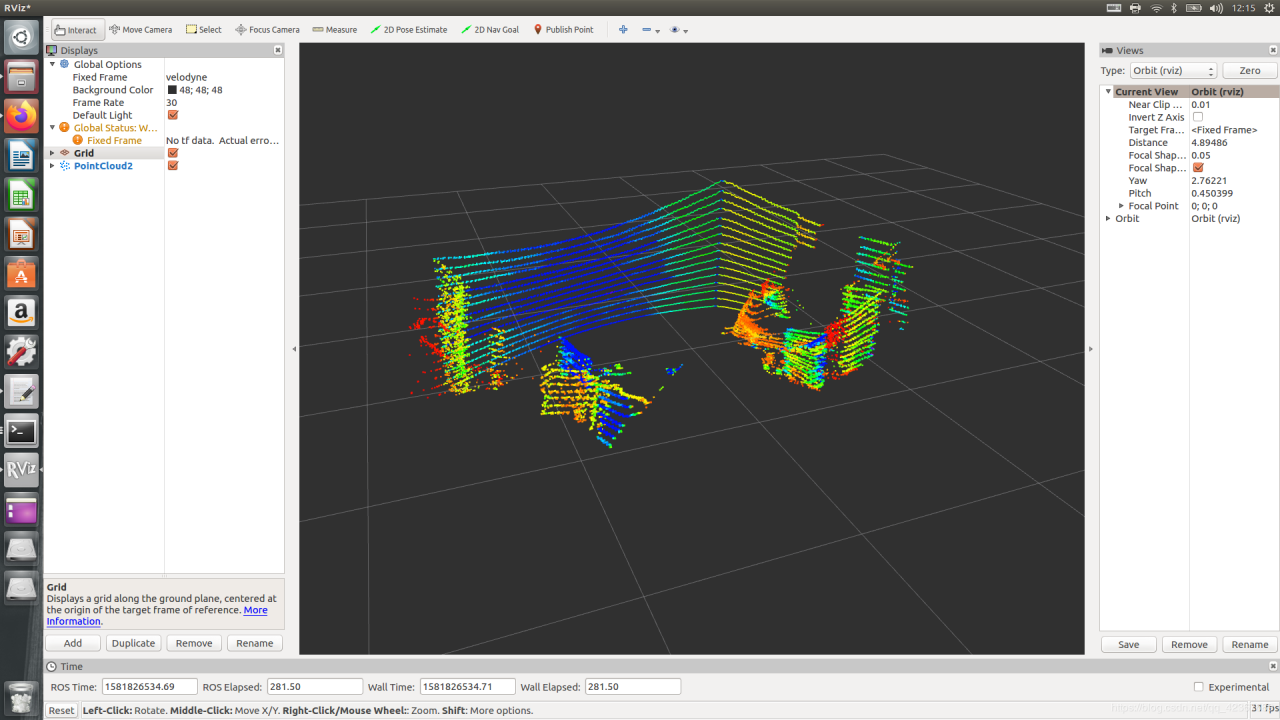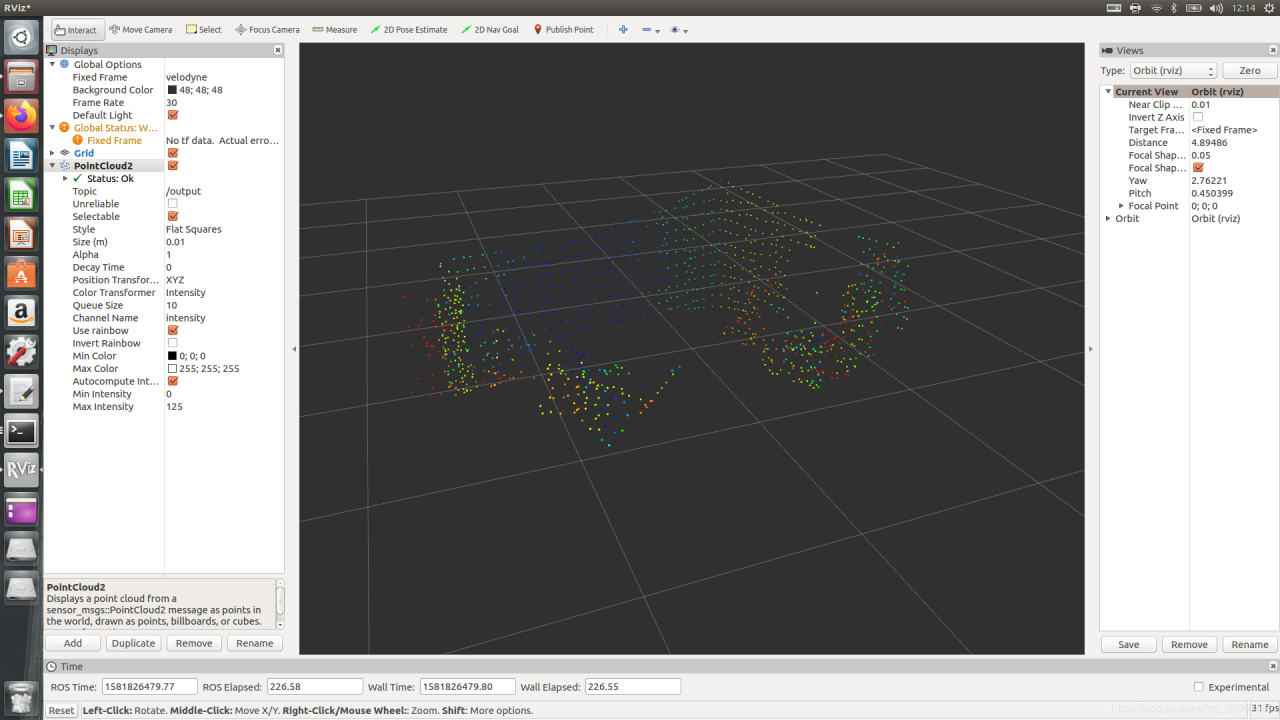在ROS中利用pcl库编程(详细)
最近在做用激光雷达建图的课题,需要在ROS系统下进行编程,其中涉及到很多对点云数据处理的算法,例如降采样、地面分割等。在点云数据处理上,目前pcl库(Point Cloud Library) 已经有了很好的支持和实现,在ROS编程时可以直接引入利用,但需要做必要的链接和转换,本文针对如何在ROS中实现pcl库的使用问题进行探讨。
参考原文博客:如何在ROS中使用PCL–数据格式(1)
参考ROS Wiki 网站:ROS中的pcl教程
与在ROS中新建功能包(package)并实现节点(node)功能一样,可以依照下面的流程:
1、新建工作空间(work space)
$ mkdir -p ~/catkin_ws/src (catkin_ws修改为你的工作空间的文件名称)
编译工作空间并设置环境变量
$ cd ~/catkin_ws/
$ catkin_make
$ source devel/setup.bash
$ echo $ROS_PACKAGE_PATH
在echo返回的路径中找到当前工作空间的目录即为设置成功。
2、新建功能包(package)
$ cd ~/catkin_ws/src
$ catkin_create_pkg pcl_VoxelGrid roscpp pcl_ros pcl_conversions sensor_msgs
$ cd ~/catkin_ws
$ catkin_make
$ . ~/catkin_ws/devel/setup.bash
功能包的名称和后面指定依赖的库文件根据实际修改,注意其中pcl_ros、和pcl_conversions两项,这是ROS与pcl库的接口。
3、package.xml文件配置
这里以利用VoxelGrid方法对点云数据降采样为例。
创建功能包的命令:
catkin_create_pkg pcl_VoxelGrid roscpp pcl_ros pcl_conversions sensor_msgs
然后在package.xml文件中添加:
libpcl-all-dev
libpcl-all
文件完整的内容:
pcl_VoxelGrid
0.0.0
The pcl_VoxelGrid package
catkin
pcl_conversions
pcl_ros
roscpp
sensor_msgs
pcl_conversions
pcl_ros
roscpp
sensor_msgs
libpcl-all-dev
libpcl-all
pcl_conversions
pcl_ros
roscpp
sensor_msgs
4、编辑cpp文件
在src文件夹下新建文档,并重命名为VoxelGrid_filter.cpp。
复制下面的代码到文件中:
#include
// PCL specific includes
#include
#include
#include
#include
#include
ros::Publisher pub;
void
cloud_cb (const sensor_msgs::PointCloud2ConstPtr& cloud_msg)
{
// Container for original & filtered data
pcl::PCLPointCloud2* cloud = new pcl::PCLPointCloud2;
pcl::PCLPointCloud2ConstPtr cloudPtr(cloud);
pcl::PCLPointCloud2 cloud_filtered;
// Convert to PCL data type
pcl_conversions::toPCL(*cloud_msg, *cloud);
// Perform the actual filtering
pcl::VoxelGrid sor;
sor.setInputCloud (cloudPtr);
sor.setLeafSize (0.1, 0.1, 0.1);
sor.filter (cloud_filtered);
// Convert to ROS data type
sensor_msgs::PointCloud2 output;
pcl_conversions::moveFromPCL(cloud_filtered, output);
// Publish the data
pub.publish (output);
}
int
main (int argc, char** argv)
{
// Initialize ROS
ros::init (argc, argv, "my_pcl_tutorial");
ros::NodeHandle nh;
// Create a ROS subscriber for the input point cloud
ros::Subscriber sub = nh.subscribe ("velodyne_points", 1, cloud_cb);
// Create a ROS publisher for the output point cloud
pub = nh.advertise ("filtered_points", 1);
// Spin
ros::spin ();
}
代码的主体内容来源于ROS与pcl教程源代码范例。对其中的订阅和发布的话题名称作了修改,订阅的/velodyne_points话题来自激光雷达VLP-16发布。
5、编辑CMakeList.txt文件
在完成源代码编辑后,对CMakeList.txt文件进行修改。
添加两行:
add_executable(VoxelGrid_filter src/VoxelGrid_filter.cpp)
target_link_libraries(VoxelGrid_filter ${catkin_LIBRARIES})
完整的CMakeList.txt文件内容:
cmake_minimum_required(VERSION 2.8.3)
project(pcl_VoxelGrid)
find_package(catkin REQUIRED COMPONENTS
pcl_conversions
pcl_ros
roscpp
sensor_msgs
)
include_directories(
# include
${catkin_INCLUDE_DIRS}
)
add_executable(VoxelGrid_filter src/VoxelGrid_filter.cpp)
target_link_libraries(VoxelGrid_filter ${catkin_LIBRARIES})
6、编写launch文件
在src文件夹下新建pcl_VoxelGrid.launch文件,添加下面内容:
7、编译功能包
回到工作空间的根目录进行编译:
$ cd ~/catkin_ws/
$ catkin_make
在devel/lib目录下会生成节点的可执行文件:pcl_VoxelGrid_node
在命令下可用roslaunch命令对节点进行启动(先source,不然可能找不到package):
$ source devel/setup.bash
$ roslaunch pcl_VoxelGrid pcl_VoxelGrid.launch
在启动激光雷达工作的情况下,节点工作并会发布/filtered_points的话题,可用rivz工具进行可视化。
$ rosrun rviz rviz
打开rviz后点击Add,添加by Topic,选择filtered_points话题,可以看到降采样后的点云。

 在CSDN上受益无限,第一次尝试写博客,作为学习心得与大家分享!
在CSDN上受益无限,第一次尝试写博客,作为学习心得与大家分享!
作者:qq_42367689